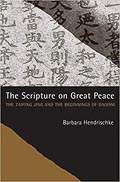start > Klassieke teksten > Late Han tot Tang > tekst
太平經 Taiping jing
Tàipíng jīng
Engelse titel: The Scripture on great peace
ook Taiping qingling shu 太平清領書 -Book of the Pure Commands of the Great Peace.
Barbara Hendrischke, who has published an English translation of a significant portion of The Great Peace (juan 35–37, 39–49),19 argues that the bulk of the material in The Great Peace only makes sense if understood as issuing from the context of the popular Daoist religious movements of the Han dynasty. Most of it bears the format of conversations between an anonymous figure known as the Heavenly Master (Tianshi 天師) and his disciples who are referred to as Genuine Persons (zhenren 真人). The Heavenly Master presents himself as being on a mission from “Heaven” (tian 天) to proclaim a message that can reform government and society in a manner by which the impending apocalypse can be averted, a peaceful, just and happy society can be real- ized, and the best of people can attain immortality. (Eskildsen 2015 p35)
Schipper schrijft:
"Scripture of the Great Peace." The term taiping 太平 occurs from early Han
times (206 B.C.-A.D. 220), caracterizing the result of good government. The work expounds cosmological theories and moral precepts for the improvement of the state and of the world in general.
This text was originally divided into ten parts, numbered according to the Celestial Stems (jiǎ
甲, yǐ 乙, bǐng 丙, dīng 丁 etc.) Each part comprised seventeen juan , containing an unequal number of chapters (pian.). According to a table of contents found in a Dunhuang manuscript the number of pian of the entire scripture totaled 366.
A work with the term taiping in its title is first mentioned in several places in the Han shu in connection with the events of the years 33 B.C. to A.D. 9. Called Scripture of the Great Peace and the Conservation of the Origin According to the Calendar of the Officials of Heaven (Tianguan Ii baoyuan taiping jing), this work was said to have been revealed by the immortal Chijing zi and to have contained instructions for the renewal of the heavenly mandate of the dynasty.
The traditions surrounding the present Taipingjing all center, however, on a second revealed text bearing the title Book of the Great Peace with Blue-Green Headings (Taiping qingling shu) It was presented to the Han throne in 166 as having been obtained from a holy man named Gan Ji or Yu Ji from Langye.
From the third through the fifth centuries, the Taipingiing (like the Xiang'er texts) was transmitted by the Way of the Heavenly Master. (Schipper 2004 p279-80).
Jan de Meyer waarschuwt om het boek niet te snel als Daoístisch te bestempelen:
For every argument in favor of a Daoist label, another one suggesting the opposite can be found. The attention given to topics such as the selection of officials, the repeated injunctions to embody key Confucian values (filial piety, propriety, and rightness), as well as the similarities in worldview between the authors of the Taiping jing and scholar officials such as Xun Yue 荀悅 (pp. 148–209), all hint at a considerable distance between the aiping jing and Celestial Master Daoism. More significant in the context of the monograph under review are the facts that divination was discouraged by early Celestial Master Daoists (see, among others, Peter Nickerson, “Shamans, Demons, Diviners and Taoists: Conflict and Assimilation in Medieval Chinese Ritual Practice (c. AD 100–1000)” in Taoist Resources 5.1, 1994), and that the very attitude of believing in the possibility of gaining knowledge about the future was frowned upon. As late as the eighth century, Wu Yun 吳筠, whose religious praxis was firmly rooted in the Celestial Master tradition, even singled out foreknowledge (qianshi 前識) as one of the causes guiding people away from the path to immortality (see my Wu Yun’s Way. Leiden: Brill, 2006, pp. 297–298).
It will be obvious that the label “Daoist” needs to be used with the greatest circumspection when dealing with the aiping jing The above remark is not to be taken as criticism but merely as a caution. (
China Review International: Vol. 23, No. 4, 2016 p 366)
Literatuur en vertalingen
Toelichting bij de literatuur
Zie ook:
Eskildsen, Stephen (2015). Daoism, Meditation, and the Wonders of Serenity: From the Latter Han Dynasty (25-220) to the Tang Dynasty (618-907). SUNY Press. Hoofdstuk 2 p31-64
Hieronder kunt u een selectie maken van de verschillende publicatievormen en de taal. Ik beperk me tot vier taalgebieden (Nederlands, Engels, Frans en Duits). De meeste literatuur is overigens engelstalig. U kunt bij teksttype ook apart de vertalingen selecteren en U kunt desgewenst ook een specifieke auteur zoeken.
Boeken 1 tot 9 van de 9

Espesset, Grégoire (2008). Editing and Translating the Taiping Jing and the Great Peace Textual Corpus. Journal of Chinese Studies, Vol. 48, pag. 469-486. *.

Ook online.
Meer informatie...

Hendrischke, Barbara (2020). Oneness in the Taipingjing. Dao Companion to Xuanxue 玄學 (Neo-Daoism), Vol. hst 4, pag. 57-80. *.

ISBN13: 978-3447108041
Meer informatie...

ISBN13: 978-0520286283

Kaltenmark, Max (1979). The Ideology of the Tai Ping ching. In Holmes Welch, Facets of Taoism hst 1, pag. 19-52 *. Yale University Press

Mansvelt Beck, B.J. (1980). The Date of the 'Taiping Jing'. T'Oung Pao, Vol. 66 (4-5) *.
Boeken 1 tot 9 van de 9


